

Ang mga artikulo na ito ay mga buod na ng pananaliksik at datos sa site

41% kababaihan at hindi sumusunod na mga indibidwal humaharap ng berbal o pisikal na sekswal na panliligalig sa trabaho
Sa karaniwan, 30% ng mahigit 2,000 media professional na na-survey ng WAN-IFRA Women in News sa pagitan ng Nobyembre 2020 at Setyembre 2021 ay nakatanggap ng pandiwang at/o pisikal na sekswal na panliligalig sa trabaho. Kapag naka-segment ayon sa kasarian, ang bilang na ito ay tumataas sa average na 40% para sa mga kababaihan at hindi sumusunod sa kasarian na mga indibidwal. Sa karaniwan, 12% ng mga lalaking respondent ang nag-ulat na nasa dulo ng sexual harassment.
Nakakabahala, sa average, 1 sa 10 ng lahat ng mga respondent ay nag-uulat na sila ay na-harass ng 5 beses o higit pa.

1 sa 10 respondent ang nagsasaad na sila ay na-harass ng 5 beses o higit pa
Ang isa pang nakababahalang trend sa lahat ng 20 market ay ang hindi pagpayag na mag-ulat ng mga insidente kapag nangyari ang mga ito. Sa karaniwan, 1 lamang sa 5 insidente ng sexual harassment ang pormal o impormal na tumataas sa loob ng mga organisasyon ng media.
Pare-pareho din sa lahat ng 5 rehiyon: isang hindi sapat na rate ng pagtugon sa ngalan ng mga organisasyon kapag nakatanggap ng reklamo. Sa karaniwan, ang pagkilos ay ginagawa lamang ng mga organisasyon sa mahigit kalahati lamang ng mga naiulat na kaso. At kapag may ginawang aksyon, ang pinakakaraniwang tugon ay ang "babalaan ang may kasalanan".
Ang pinakamadalas na binanggit na mga gumagawa ng sexual harassment ay ang mga kapwa empleyado (39.3%), na sinusundan ng mas mataas na pamamahala (18,9%) o, isang direktang superbisor (19%).
Sekswal na panliligalig para sa babae
Ang mga rate ng pag-uulat ayon sa rehiyon ay nagpapakita rin ng ilang pagkakaiba-iba, kung saan ipinapakita ng Central America ang pinakamataas na antas ng pag-uulat, sa 26% at ang Rehiyon ng Arab ay nagpapakita ng pinakamababa, sa 15%.
Nang tanungin kung ano ang nasiraan ng loob na pag-uulat, ang napakaraming tugon ay tumutukoy sa kawalan ng pag-unawa o kamalayan sa mga paraan upang mag-ulat ng mga insidente, at takot sa mga epekto kung ang mga insidente ay naiulat. Wala pang 11% ng mga respondent ang nag-ulat na alam kung ang kanilang mga organisasyon ay may patakaran sa sekswal na panliligalig.
Sa paglipas ng 12-buwang pag-aaral, ang WAN-IFRA Women in News ay nagsagawa ng malalim na panayam sa 85 senior media executive mula sa 18 sa 20 target na bansa. Ang isang pare-parehong trend na natukoy ay ang disconnect sa pagitan ng perception at realidad na hawak ng mga executive pagdating sa pag-unawa sa laki ng problema sa loob ng kanilang organisasyon ng media o sa industriya sa pangkalahatan sa kanilang partikular na merkado.
43.5% ng mga executive ng media na nakapanayam ay nag-ulat na sila mismo ay nakaranas ng sekswal na panliligalig. Gayunpaman sa loob ng parehong grupong ito, 27% lang ang nakakaramdam na ang sekswal na panliligalig ay isyu pa rin sa industriya. Nadagdagan pa ito ng kawalan ng kamalayan sa sarili nilang mga patakaran sa sekswal na panliligalig: Mahigit 1 sa 10 nakapanayam ang nakakaalam kung may patakaran sa sekswal na panliligalig ang kanilang mga organisasyon.
Ang kakulangang ito ng kamalayan sa lawak ng isyu ay maaaring dahil sa mababang antas ng pag-uulat - na sa sarili nito ay sintomas ng kawalan ng kalinawan sa kung paano mag-ulat ng insidente kapag ito ay lumitaw, gaya ng nakabalangkas sa itaas.
May mga malinaw na hakbang na maaaring gawin ng mga organisasyon ng media upang tumulong na masangkapan ang kanilang mga management team ng mga tamang tool upang matugunan at mabawasan ang sekswal na panliligalig sa lugar ng trabaho. Ang isang malinaw na tinukoy at naa-access na patakaran sa sekswal na panliligalig ay mahalaga. Ang pagsasanay sa mga tagapamahala kung paano tugunan ang mga insidente sa isang magalang na paraan kapag nangyari ang mga ito, ay isa pa. Bilang mahalagang unang hakbang, mas mauunawaan ng mga tagapamahala ng media ang lawak ng problema sa pamamagitan ng pagsasagawa ng anonymous na panloob na survey.
Tulad ng ipinapakita ng mga natuklasan mula sa pandaigdigang pananaliksik na ito, ang sekswal na panliligalig ay nananatiling isang malaganap na problema sa industriya ng media.
Matuto nang higit pa tungkol sa kung ano ang maaaring gawin upang matugunan ang sekswal na panliligalig sa iyong organisasyon ng media: dito
African media has a sexual harassment problem. But many cases of physical and verbal sexual harassment go unreported because of fear of further victimisation and a lack of confidence in management systems and interventions. When action is taken, results are often underwhelming.
WIN’s latest research, the first phase of a multi-region study, set out to collect credible information about the scale of harassment in news outlets in Africa and to establish what was being done to provide safer newsrooms.
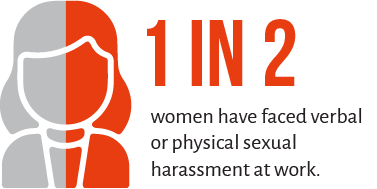
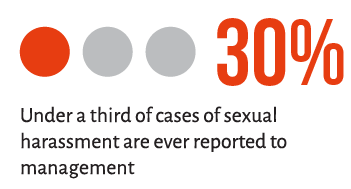
575 survey respondents, from eight countries, namely Kenya, Malawi, Zambia, Zimbabwe, Botswana, Tanzania, Uganda and Rwanda, responded to questions on sexual harassment at work - verbal and/or physical. It found:
Fear prevented many from filing formal complaints. These were the common concerns:
The absence of and lack of awareness of reporting mechanisms also explained inaction.
Almost half, 46.7%, of those surveyed said their organisation had no sexual harassment policy, 35.9% were unaware of what was in the policy and just 17.4% were aware of its contents.
Of the 32 managers interviewed 68.7% said their organisation had a sexual harassment policy - 46.7% had been trained on it.
Perhaps the biggest impedance in reporting is that the perpetrators are often managers or supervisors - people with responsibility and power. Survey respondents identified their harassers as fellow employees (in 38.8% of cases) but 22.1% of the time they were direct supervisors and in 19.4% of cases, members of higher management.
When action was taken in 57% of cases reported, the most common organisation response was to warn the perpetrator (46.2%). 14.5% of responses said training was offered and 9.7% had the case dismissed.
“The research highlights a lack of trust in the organisation, or sometimes complete failure of management and systems, to deal effectively with sexual harassment,” said Melanie Walker, WAN-IFRA’s Executive Director, Media Development and Women in News.
“This matters because the less confidence there is in an organisation’s ability to address the problem, fewer people will see value in calling it out, and so the cycle will perpetuate.” There are solutions, however, beginning with owners and managers acknowledging the problem exists and then committing to ensuring a safer working space, not just for women, but for all staff. It is vitally important to change the culture of silence around harassment. And this culture change can only come from the very top.”
In supplementary interviews with 32 media managers, we found
“There are divergent views on the scale of sexual harassment between the survey respondents and managers we interviewed. There is no simple explanation for this - but what is common is that both staff and managers have had first-hand experience of sexual harassment, and in most cases chose not to report it. This suggests fear of victimisation runs alongside a lack of confidence in management systems and any apparent remedies,” said Walker.
Women in News, which offers expert input on how to manage sexual harassment, is starting to see little victories among those media organisations that have begun to actively manage the problem - starting with adopting policies and procedures that the staff can support. “But the numbers are very small and we have a very long way to go before staff are convinced and comfortable that if there are incidents of harassment, they can report them, and action will be taken, without further victimisation,” said Jane Godia, Africa Director of WIN and an expert and trainer managing sexual harassment.
“We are still working on changing perceptions and debunking cultural beliefs that perpetuate sexual harassment,” said Godia.
Ang pananaliksik na ito ay nagbigay ng katibayan ng pangangailangan para sa mga organisasyon ng media na kilalanin ang lawak ng sekswal na panliligalig at ilagay sa mga plano ng mga hakbang upang magbigay ng isang mas ligtas na kapaligiran sa pagtatrabaho.
"Nagsisimula ang lahat sa isang pag-uusap sa kung ano ang at hindi katanggap-tanggap na pag-uugali sa iyong organisasyon ng medya. - pagiging tahasang tungkol sa sekswal na panliligalig - pagbabahagi ng mga kahulugan, kung anong mga pag-uugali ang hindi katanggap-tanggap, at pagpapahayag ng karapatan para sa bawat empleyado na tratuhin nang pantay-pantay. Hindi sapat na magkaroon ng patakaran; Ang mga kawani at tagapamahala ay dapat na sanayin sa kung ano ang mga pamamaraan para sa paggawa at pamamahala ng isang reklamo. Dapat maging malinaw ang lahat tungkol sa mga kahihinatnan ng sekswal na panliligalig. Mas mainam na maging maagap at handa kaysa itulak sa isang posisyon sa pamamahala ng krisis kapag may lumabas na kaso," sabi ni Walker.
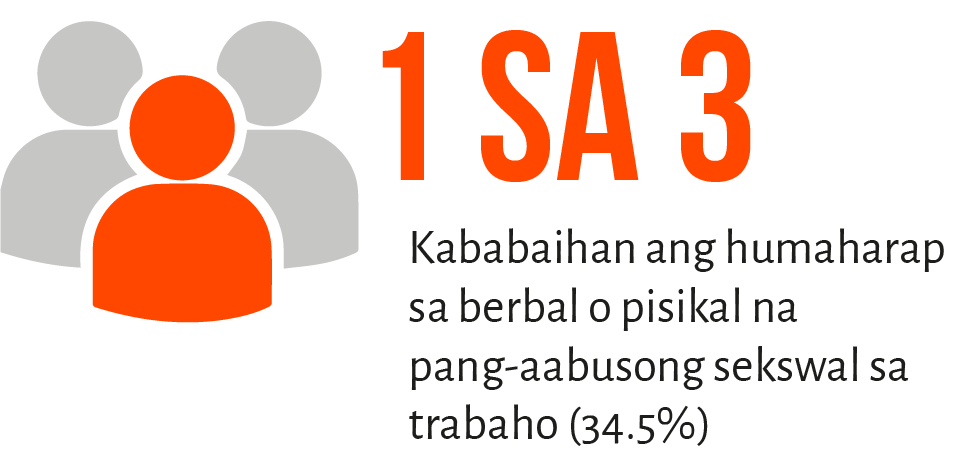
Ang paraan kung paano pinamamahalaan ang mga organisasyon ng medya ay, karaniwang, na-impluwensyahan ng paniniwala na ang mga empleyado ay alam kung paanu maging maayos. Subalit, ang katotohanan ay nananatili ang sekswal na panliligalig na medyo laganap – particular na sa mga kababaihan – at kadalasan ay hindi nai-ireport. Sa hindi bababa sa isa sa limang kaso ang naiuulat sa tagapagpamahala, makikita ang kultura ng pananahimik at nagpapatuloy ang takot.
Pinagsama-sama ang problemang ito ng pagkakaiba sa pagitan ng mga ehikutibo at empleyado sa sukat ng problema. Sa kabila na isa sa tatlong kababaihan ang humaharap sa sekswal na panliligalig sa trabaho, 84.1% ng ehekutibong napanayam ang naniniwala na hindi problema ang sekswal na panliligalig sa industriya ng pagbabalita. Ito ay makabuluhang agwat sa pang-unawa.
Ang mga resultang ito ang huhubog ng bahagi ng isang maraming rehiyonal na pag-aaral upang makapagbigay ng ebidensya ng lawak ng sekswal na panliligalig. Ang kabuuang pananaliksik ang makakatulong upang mas maintindihan ang mga pagkakatulad at pagkakaiba na hinaharap ng medya sa Global South.

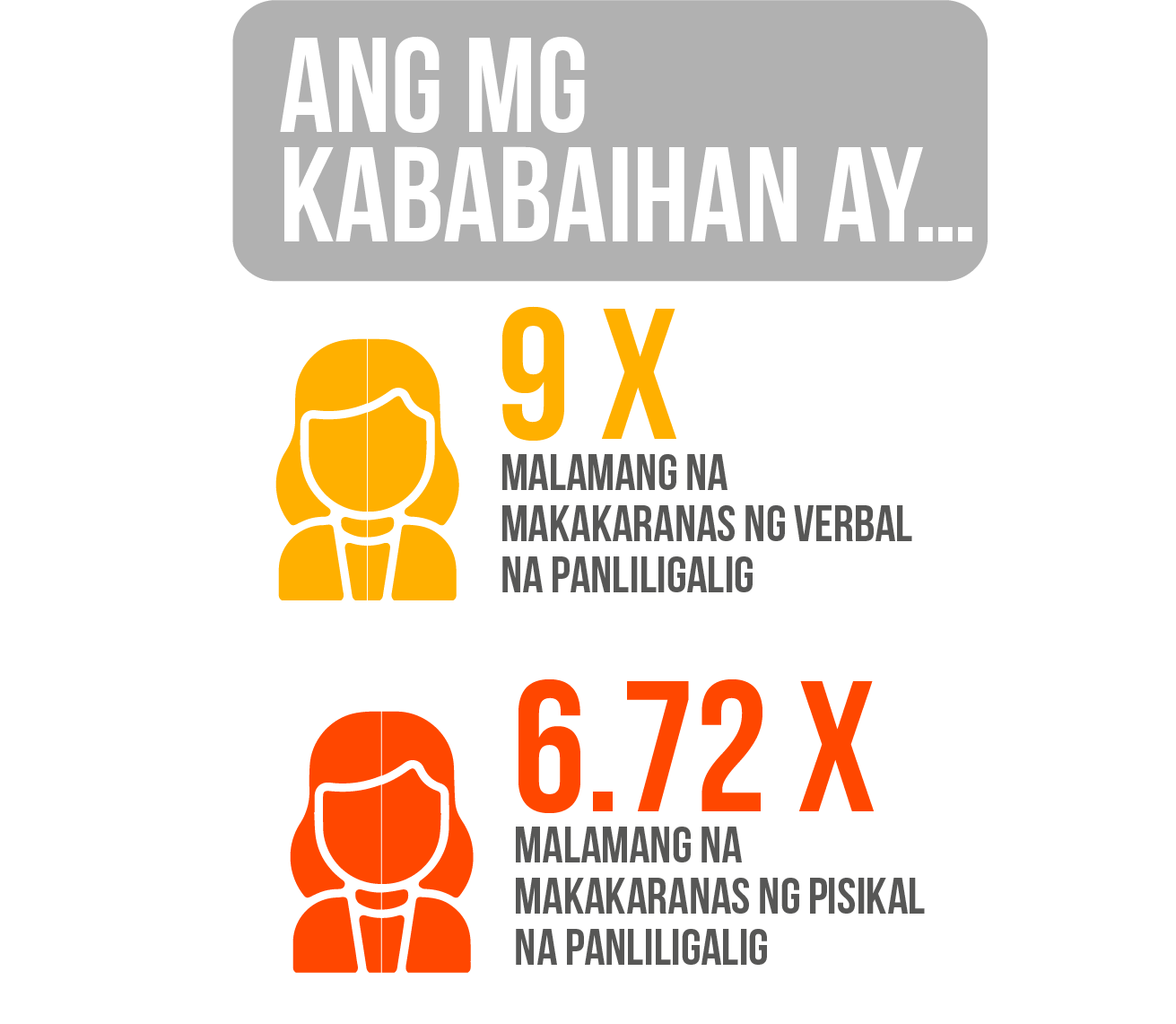
494 sa mga survey respondents, mula sa limang mga bansa, gaya ng Indonesia, Myanmar, Malaysia, Philippines, at Vietnam, ang sumagot sa mga tanong ukol sa sekswal na panliligalig sa trabaho – berbal at/o pisikal. Nakita na:
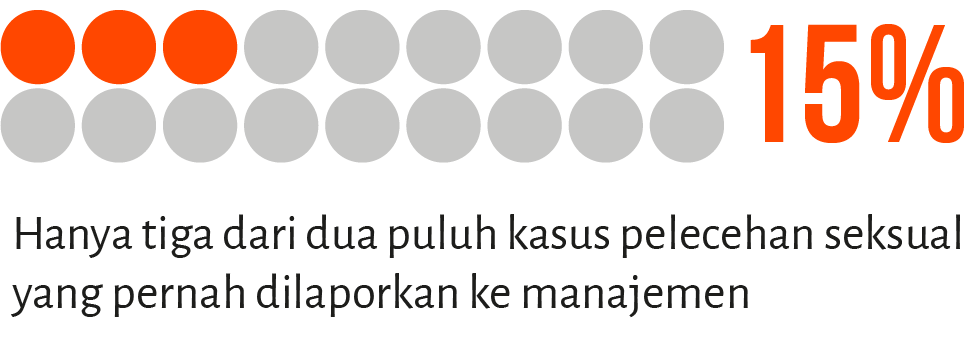
Ang hindi tamang pag-ulat ng sekswal na panliligalig ang “endemic” sa kaparehong empleyado at ehekutibo na lebel. Kasama ang 15% na reporting rate sa mga survey respondents, ang mga ehikutibo mismo ang nag-report lang ng mga insidente na nangyari sa kanila 33% kadalasan (anim sa 19 na mga ehekutibo na nakaranas ng sekswal na panliligalig gayunpaman dalawa lang ang nag-ulat nito.
Syempre gusto namin na makita na may ginawang aksyon, subalit sa 42% lang ng ehekutibo na nagpahiwatig na may kamalayan sila sa kanilang polisiya sa kompanya ukol sa sekswal na panliligalig ang resulta ay hindi nakakagulat.
Sa mga karagdagang panayam sa 19 ehikutibo ng medya, nakita naming
Ang pagpapataas ng edukasyon tungkol sa mga patakaran sa sekswal na panliligalig at kung paano ipatupad ang mga ito ay isang unang hakbang sa pagpapabuti ng mga pagkakataon ng pagkilos na ginagawa. Sa tatlo lamang sa walong ehikutibo na nakakaalam tungkol sa mga patakaran na personal na sinanay, maaari itong magkaroon ng malaking epekto. Sinusuportahan ito ng higit sa kalahati ng mga ehikutibo na nanawagan para sa higit pang pagsasanay sa kung ano ang bumubuo sa sekswal na panliligalig at kung paano tumugon.
Marahil ang pinakamalaking balakid sa pag-uulat ang mga pasimuno ay madalas na mga tagapamahala o tagapangasiwa - mga taong may responsibilidad at kapangyarihan. Tinukoy ng mga sumagot sa survey ang kanilang mga nanliligalig bilang mga kapwa empleyado (sa 35.2% ng mga kaso) ngunit 18.6% kadalasan sila ay miyembro ng mas mataas na pamamahala at sa 12.7% ng mga kaso, mga direktang tagapangasiwa.
"Ang pananaliksik ay nagpapakita ng hindi pagkakasundo tungkol sa paglaganap ng sekswal na panliligalig sa mga newsroom. Naniniwala ang 73.6% ng mga ehikutibo na hindi ito isang problema, na may karagdagang 10.5% na naniniwala na ito ay isang bagay ng nakaraan. Ito ay lubos na kaibahan sa isa sa tatlong kababaihan na nakaranas ng ilang uri ng panliligalig sa trabaho - pati na rin ang 4% ng mga lalaki, "sabi ni Melanie Walker, WAN-IFRA’s Executive Director, Media Development and Women in News.
"Ito ay problema dahil ang unang hakbang sa pagtugon sa sekswal na panliligalig ay maunawaan kung ano ito at sumang-ayon na ito ay umiiral. Natutuwa kaming makita ang mga ehikutibo na sumasang-ayon na higit pang pagsasanay ang kailangan para mas maunawaan ang sekswal na panliligalig at kung paano ito pangasiwaan. Kami ay umaasa na ang patuloy na pakikipagtulungan sa mga organisasyon ng medya sa buong rehiyon ay makakatulong sa pagresolba sa mga hindi pagkakasundo o hindi pagkakaunawaan.”
Ang Women in News, na kamakailan ay lumawak sa Southeast Asia, ay nag-aalok ng ekspertong input sa kung paano pamahalaan ang sekswal na panliligalig. Ang direktang pakikipagtulungan sa mga newsroom pati na rin sa mga indibidwal sa pamamagitan ng Leadership Accelerator, ang mga tagapamahala at empleyado ay maaaring magkaroon ng mga patakaran at pamamaraan upang aktibong pamahalaan ang problema. Ngunit marahil ang mas mahalaga, ang mga indibidwal ay nakakakuha ng tulong upang mas maunawaan ang kanilang mga karapatan at maunawaan ng mga organisasyon ng medya ang kanilang mga responsibilidad. "Ito ay isang mahabang daan sa hinaharap, simula sa pagbuo ng isang karaniwang pag-unawa sa kung ano ang sekswal na panliligalig at kung bakit ito nagpapatuloy. Ang pag-alis nito sa bawat newsroom ay lilikha ng mas ligtas na kapaligiran sa pagtatrabaho at kapaligiran kung saan mas madaling umunlad ang mga kababaihan," pahayag ni Khin Thandar Htay, Southeast Asia Director of WIN.
Ang pananaliksik na ito ay nagbigay ng katibayan ng pangangailangan para sa mga organisasyon ng media na kilalanin ang lawak ng sekswal na panliligalig at ilagay sa mga plano ng mga hakbang upang magbigay ng isang mas ligtas na kapaligiran sa pagtatrabaho.
"Nagsisimula ang lahat sa isang pag-uusap sa kung ano ang at hindi katanggap-tanggap na pag-uugali sa iyong organisasyon ng medya. - pagiging tahasang tungkol sa sekswal na panliligalig - pagbabahagi ng mga kahulugan, kung anong mga pag-uugali ang hindi katanggap-tanggap, at pagpapahayag ng karapatan para sa bawat empleyado na tratuhin nang pantay-pantay. Hindi sapat na magkaroon ng patakaran; Ang mga kawani at tagapamahala ay dapat na sanayin sa kung ano ang mga pamamaraan para sa paggawa at pamamahala ng isang reklamo. Dapat maging malinaw ang lahat tungkol sa mga kahihinatnan ng sekswal na panliligalig. Mas mainam na maging maagap at handa kaysa itulak sa isang posisyon sa pamamahala ng krisis kapag may lumabas na kaso," sabi ni Walker.
Women in Russian media are four times more likely to experience sexual harassment than men. A report on the scale of sexual harassment in Russia has shown how pervasive it is, yet just one-quarter of cases are ever reported to the management.
The research, commissioned by the World Association of News Publishers’ (WAN-IFRA) Women in News programme found that of those women media professionals who experienced harassment, 31% experienced verbal harassment and 14% experienced physical attacks. 22% of media professionals (men, women and gender non conforming individuals) report to experiencing harassment or some kind.
The survey, which is part of a multi-region study undertaken in partnership with City, University of London, set out to collect data on the scale of sexual harassment in media organisations in Russia, and to establish what was being done to provide safer newsrooms. 176 media professionals were surveyed. Supplementary in-depth interviews were conducted with 16 media executives.
WIN has been engaging with journalists and media managers on sexual harassment for more than 10 years. In that time, we have collected plenty of anecdotal evidence of sexual harassment. But this is the first time we have been able to draw on large-scale data to support the belief that it is prevalent everywhere and is a significant impediment to a healthy media industry, regardless of country or cultural context.
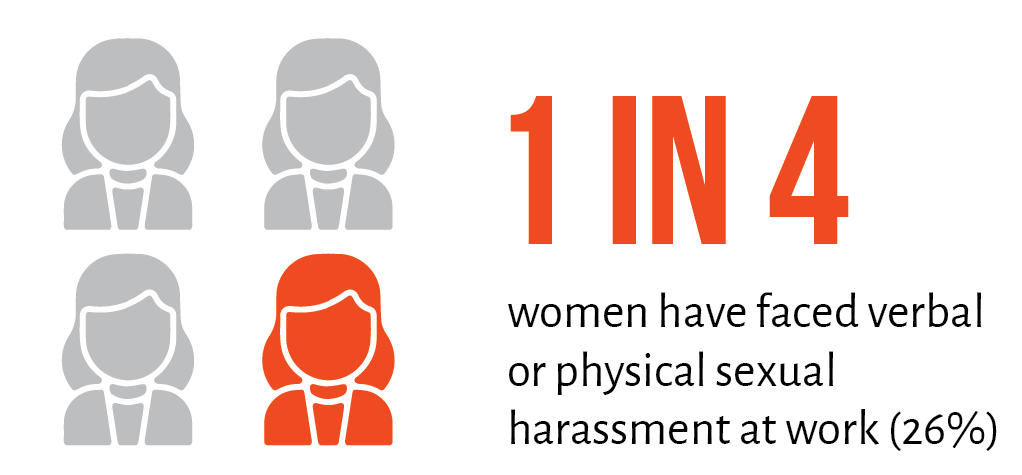
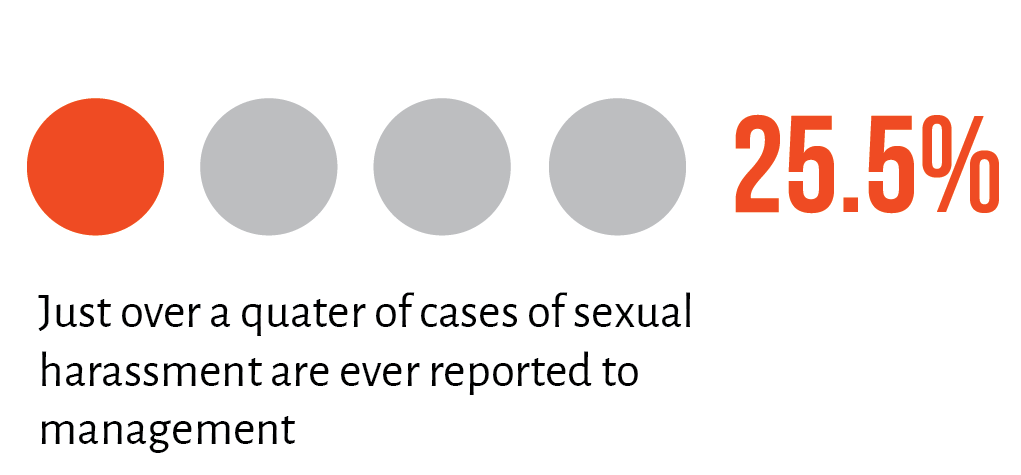
While sexual harassment in newsrooms for women is much more prevalent, men have not been spared.- though they are four times less likely to experience it than women, of those surveyed, 12 per cent had experienced verbal sexual harassment. None of them had been physically harassed.
Overall, just under one in four respondents (23.4%) had witnessed at least one incident of sexual harassment at work – but reporting of these cases remained low at 25.5 per cent.
The survey found:
In Russia, an average of 25.5% of cases of sexual harassment were reported to the management at media organisations. While 62% of these result in action by management, the low reporting rate means the majority of perpetrators are never disciplined and survivors never receive support.
Fear - fear of losing a job, negative repercussions, retaliation or being negatively labelled - was the prevailing reason for not reporting. Combined, it represents 39.7% of responses.
The top individual reasons \were no known reporting mechanisms (17.1%) and not thinking it was a big deal (15.3%).
Further, when respondents did report sexual harassment, news organisations took action less than two-thirds (62%) of the time. The most common responses from organisations when they took action were:
Direct action against the perpetrator almost never occurred. Firing, transfer, and suspension of the perpetrator were each only reported one time. The most common source of sexual harassment were fellow employees, followed by management (34.2%, combined total of direct supervisor and higher management).
“Understanding abuse of power is crucial to understanding who sexual harassment happens to and why. It tends to have nothing to do with sincere sexual or social interest. Instead, it happens where there are unequal relationships, for example between a superior and their subordinate, or between an older employee and a younger employee,” Melanie Walker, Executive Director, WAN-IFRA Women in News.
When asked if sexual harassment is an issue in the news industry, 15 news executives responded no, and one said maybe. This is in stark contrast to the 35% of women who reported experiencing verbal sexual harassment and 17% who reported experiencing physical harassment. This gap may also explain why 35% of responses said that organisational barriers, such as no reporting mechanism, not knowing how to report or thinking they wouldn’t be believed, were why they didn’t report the harassment they experienced.
To understand management perspectives on the prevalence of sexual harassment, WIN interviewed 16 managers and executives: 11 were women and five were men.
Three women stated they had experienced sexual harassment, but none had reported this.
The consensus between the news executives was that sexual harassment may occur in Russia in general, but it was an issue to be reported on, not one that was experienced by news personnel.
“I don’t think sexual harassment is a problem. If an issue arises, staff know how to defend themselves. Moreover, I have women who will fight back against anyone if this happens. We are all in a transparent environment; we see each other,” said one editor-in-chief.
“It is difficult for me to answer this question unequivocally. The honest answer: more likely yes than no,” said a deputy editor-in-chief.
When asked if any of their employees had reported cases of sexual harassment to them, three of the 16 executives answered yes, and their response was to discuss the incident with those concerned.
On reduced complaints, one CEO said: “Since the beginning of the #MeToo movement, many men have been rethinking their actions. Nonetheless, I remain concerned about sexual harassment and realise we can do better.”
Interestingly, when we asked respondents if their work environment was supportive, for women, 76.2% somewhat to strongly agreed they could openly talk to their supervisor, 88.1% somewhat to strongly agreed they felt listened to at work, and 88.8% somewhat to strongly agreed they felt safe in their newsroom. This seems to be in contrast to their experiences.
In response to a question on whether or not the executives believed their employees felt comfortable reporting sexual harassment incidences to their news organisations, 12 said yes.
“I’m sure about the women. They certainly would tell. They always talk about their problems: from health problems to personal dramas and breakups. With men, I’m not so sure. A man should deal with his problems on his own - this is the Russian mentality. You’re not a man if you show your weakness or ask for help,” said one general director.
Executives’ beliefs that sexual harassment is a non-issue in their workplace contrast with the respondents’ views, where one in four women have experienced either unwanted verbal or physical harassment at work.
Respondents said the perpetrator was most likely a fellow employee but that they do receive significant unwanted attention from people in power in the organisation - namely supervisors and executives.
The overarching stand from managers that there was no need for explicit sexual harassment policies and procedures may explain why reporting is low. A common reason for not reporting was dismissing the event as no big deal. However, one respondent pointed to a feeling of shame around verbal harassment, in line with cultural norms that silence victims.
Additionally, when asked if they knew if their organisations had an anti-sexual harassment policy, of the 16 news executives, only two were aware of such a document. And when asked to provide suggestions for eliminating sexual harassment in the news industry, they focused on the importance of communication in creating a comfortable atmosphere. Most executives believe this exists in their workplace, therefore, sexual harassment is not a significant issue.
The research findings go beyond anecdotes and demonstrate that sexual harassment does exist in Russian media organisations. The managers’ confidence that their workplaces, with their open communication policies, are not hotbeds for harassment, feeds into the notion that sexual harassment is a problem of the past and continues to create unsafe work environments for all of their staff.
The first step is making sure executives really understand what constitutes sexual harassment and just how pervasive it is. Only from there can policies be enacted and working cultures change to stamp out this scourge from all media organisations and, ultimately, all workplaces in general.
“The study showed that many publishers try to create an open, friendly atmosphere in their newsrooms and sincerely believe that this protects against harassment. But incidents can happen in any team and in any organization. It is important to know what to do and how to proceed in this case in order to protect people. You should have the reporting mechanisms, the investigative procedures and rules, the understanding of actions in response. The study revealed they do not exist, or employees do not know about them. Together with WIN WAN-IFRA, ANRI-MEDIA is taking very first steps in this direction to help media outlets create a safe business environment. For example, we adopted a WIN Guide on countering harassment in the media with practical templates and recommendations." Anna Koshman, ANRI-Media
Although 85% of sexual harassment incidents go unreported in the Arab media industry - management is starting to take some concrete actions to break the circle of silence.
526 media professionals participated in a survey from February to April 2021 distributed in Egypt, Jordan, Lebanon, and Palestine as part of a multi-region study to provide evidence of sexual harassment in the media industry. Just over half of the participants were women (54%).
On average one in three women have faced some form of sexual harassment at work (35%). More than 50% have experienced verbal harassment. Yet only 12% of incidents are reported. Men are more likely to see action taken on their behalf. On average, 50% of cases reported by men received action from their organisation, compared to 41% for women.
In addition, when asked if their organisation has an anti-sexual harassment policy, only 7% said there is one in place and they are aware of it.


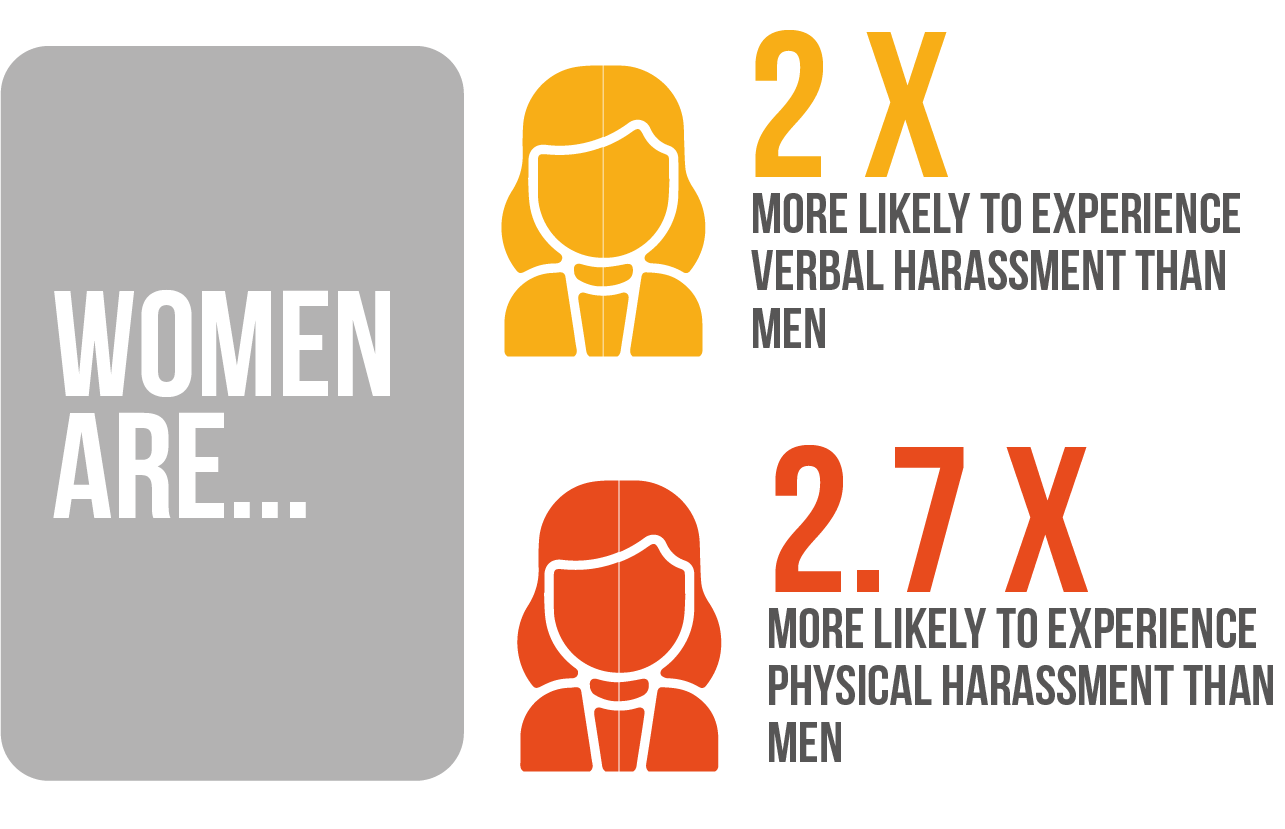
When respondents were asked questions on types of sexual harassment they faced at work women were almost twice as likely to experience verbal harassment compared to men, 52% and 24% respectively. The gap expands more when comparing data on physical harassment (19% and 7%).
Though a small sample size, of respondents who did not specify their gender in the study (almost 15% of the total responses), 29% experienced verbal sexual harassment, 14% experienced physical sexual harassment.
Furthermore, one in two participants stated that they have witnessed sexual harassment - 13.5% five or more times.
The results of this study reveals that sexual harassment is still existing, profoundly, in the media sector, which stresses the need and importance of taking actions to deal with it in an effective way.

Underreporting of sexual harassment is endemic. Providing safe space to talk freely about those cases, and guaranteeing confidentiality and protection are needed, in addition to raising the awareness of speaking up, showing the added value of protecting others from witnessing such recurrent situations.
Yet, of those reported cases, news organisations took actions 46% of the time, a step forward to activate the organisational role in ensuring safety and security of employees at the work environment.
The top reasons listed for not reporting were no known reporting mechanism available (17.3%), not having evidence (13.8%), and not wanting to be negatively labelled (12.8%). The most common responses of organisations when they took action was firing the accused (24.5%), and dismissing with no further action (20.5%).
The reasons for not reporting are brilliantly revealing the way to increase reporting rates: adapt a clear and comprehensive mechanism that applies fair rules, which help change the organisational culture to embracing openness and transparency instead of shame and blame paradox.
AR respondents revealed that the most common source of sexual harassment was a fellow employee (42.9%), followed by direct supervisor (22.2%), higher management (14.6%), other (10.7%), and news source (9.5%).
Numbers show that most sexual harassment incidents happen inside the media organisations at work, whether by the same level of management employees or higher. Firm procedures to help all staff members enjoy a safe workplace is a must.
Ang pananaliksik na ito ay nagbigay ng katibayan ng pangangailangan para sa mga organisasyon ng media na kilalanin ang lawak ng sekswal na panliligalig at ilagay sa mga plano ng mga hakbang upang magbigay ng isang mas ligtas na kapaligiran sa pagtatrabaho.
“It all starts with a conversation on what is and isn’t acceptable behaviour in your media organisation. - being explicit about sexual harassment - sharing definitions, what behaviours are unacceptable, and communicating the right for every employee to be treated equally. It is not enough to have a policy; staff and managers must be trained on what the procedures are for making and managing a complaint. Everyone should be clear about the consequences of sexual harassment. It is far better to be proactive and prepared than pushed into a crisis management position when a case emerges,” said Melanie Walker, Executive Director, WAN-IFRA Women in News.
The media industry in Nicaragua and El Salvador has a sexual harassment problem. On average, 74% of women in media have experienced verbal sexual harassment. More than 40% have experienced physical harassment. These are amongst the highest rates of sexual harassment of all countries surveyed in the 20-country study, completed in November 2021.
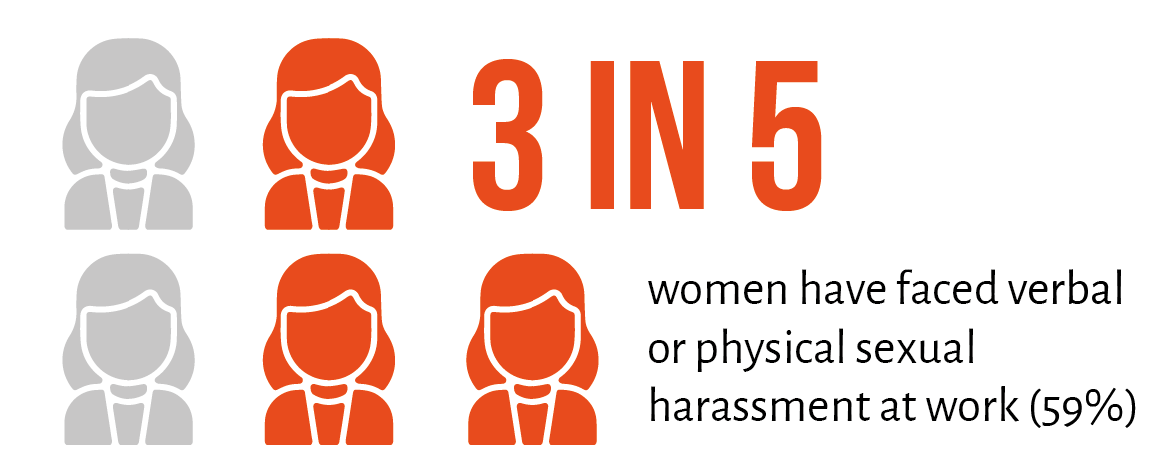
234 media professionals in Nicaragua and El Salvador participated in a survey, in addition to 18 media executives who provided supplementary in-depth interviews to understand the extent of sexual harassment in the industry.
The data shows that women are disproportionately affected, experiencing verbal and physical sexual harassment at least four times more than men. Moreover, women experience sexual harassment far more often than men, with almost half of the women surveyed indicating they have experienced verbal sexual harassment five times or more, compared to 5.8% of men.

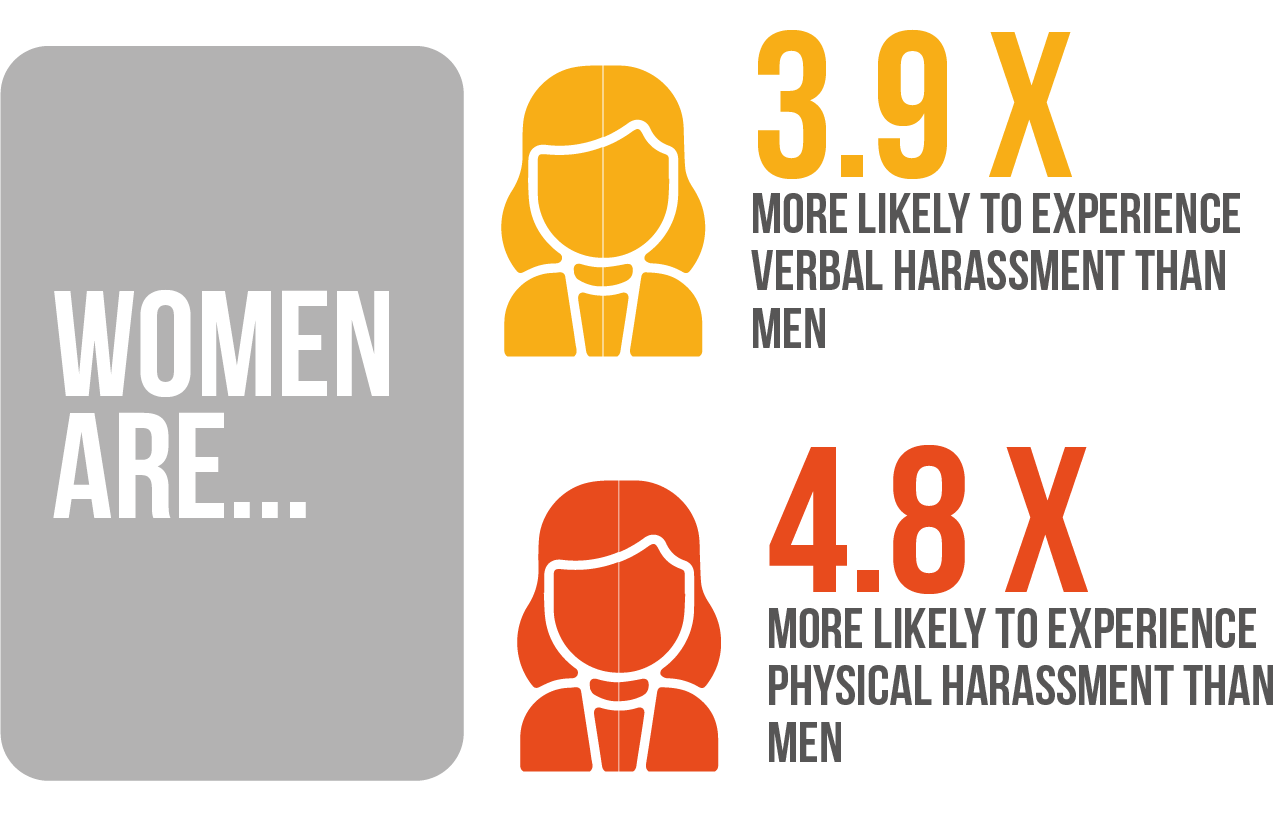
Given these high figures, it is not surprising that almost 60% of the participants had witnessed at least one incident of sexual harassment with 21% stating they had seen five or more. The most common source of sexual harassment was a fellow employee (42%), followed by higher management (25%).
Despite the high prevalence of sexual harassment, on average only one in every four cases was reported. Action was taken in just under half (46%) of incidents that were reported. Responses from both survey participants and news executives indicated the lack of a known sexual harassment policy. This is reflected by the survey respondents, where the top reasons for not reporting cited were ‘no known reporting mechanism available’ and ‘not knowing how to report’. The other reasons for not reporting were ‘fear of perpetrator retaliation’ or ‘fear of a negative impact in their professional career’.

Interestingly, when the interviewed news executives were asked if sexual harassment was a problem, the majority said yes, but not in their newsroom. More than half of the news executives interviewed stated that their newsrooms were exceptions to the overall atmosphere in the news industry, were sexual harassment was common.
The most common responses of organisations when they took action was warning the perpetrator (56.4%), offering emotional support for the victim (16%), and the victim being transferred to another department (10.3%).
Media organisations in Central America need to recognise the extent of sexual harassment and put in mechanisms to provide a safer working environment. The research shows that sexual harassment is a significant problem. The lack of policies aimed at preventing sexual harassment and at addressing it properly when it occurs, along with the common fear to report results in high levels of sexual harassment in the Central American media industry that go largely unchecked.